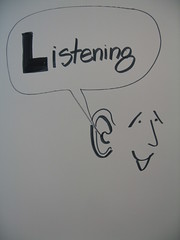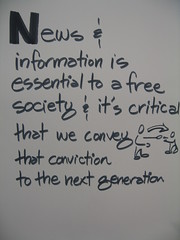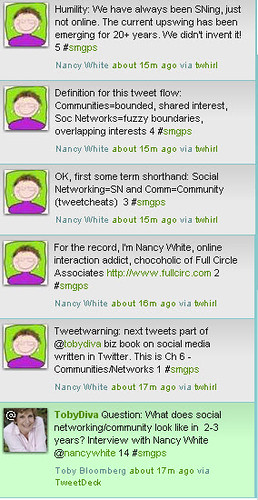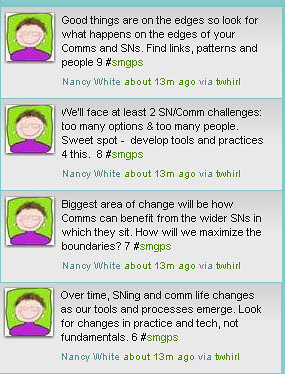As promised earlier, here is my reflection of the keynote I did at the Instructional Technology Council’s annual gathering on February 22nd. The topic was “Online Facilitation: 14 years on. What have we learned and what do we need to learn.”
As usual, I decided to try something new. Why do the same old shtick – there is no learning there? So inspired by Cliff Atkinson’s book “The Back Channel,” I decided to integrate a Twitter tool into the slides and thus into the body of the talk, consciously breaking in and out of the audience. (NOTE: Update for Timo Elliot’s Twitter tools are here: http://timoelliott.com/blog/2009/10/powerpoint-twitter-tools-update-make-some-noise.html )
Below I’ll share first, my reflections on the session, then links to all the session artifacts.
First: Reflection
My topic was about my past experience with online facilitation and where I thought it was headed. After a moment’s inspiration in yoga class, I realized the metaphor of the practice of yoga fit – both as a thread and a fun visual tool, which of course sent me scurrying to Flickr for creative commons photos. There was a wealth!
Cliff had graciously sent me a copy of the book, but I had not read it until last week. Perfect timing. As I read about some tools Cliff had found for integrating Twitter backchannel into a talk, I decided this was the perfect opportunity to both talk about a practice, PRACTICE the practice and do something to increase the interactivity of a keynote.
Let me stop for a second and share too, that the stakes were high. The conference started with an amazing “Late Night Learning Live” biting and sharp comedy set up by Jared Stein and Marc Hugentobler. They were brilliant. Stein has a career as a deadpan comedian, with the look and timing to match. The videos they included were rip-snorting and the commentary hit the spot. For more, see Jim Groom’s review of their session.
Then Sunday morning, the “supreme artist of North America” (did ya see, I wrote it, Jim!) “Reverend” Jim Groom lit up the room with fabulous, concreted examples of open learning at Mary Washington University, replete with volunteer choir and “Amen’s” from the crowd. (Well, that was me. I could not resist.) So the heat was on. This was no “low expectation” moment. I even skipped the drinking and partying Sunday night to prepare. 😉
The content you can view through the artifacts below, so I’ll reflect on the Twitter backchannel experiment. To prepare, I downloaded the SAP Twitter tools from Timo Elliott and installed them. And of course, tested them. Then I used Cliff’s advice about how to frame key messages in 140 characters or less so they could easily be tweeted by the audience. To focus the backchannel, I used Timo Eliott’s autotweet tool. This means I embedded a bit of code in my slide notes pages that would generate an autotweet with that text when the slide came up. I did not autotweet on everyslide, but only on the main points. You can read the auto tweet in the PDF of the slides and notes. This practice not only helped me focus (which is difficult for me. I’m a rambler) but it also turned out to be a very effective way of creating some “retweetable” moments during the talk. More on that later.
The next morning I arrived early – always an important speaker practice. I set up the lapt top to test the backchannel pages and THEY DIDN’T WORK. Barry Dahl, who had been my support team and encouragement, and I tried to figure it out. Finally, it dawned on me. There had been a Window’s update and then an Adobe Flash update. The slides used Flash. A quick download and all was well. Ready to start.
At the beginning of the talk, I did an in room activity to identify who knew what Twitter was (just about everyone), who had an account, who had used the account for more than two weeks and who was Tweeting live. I was inspired by a conversation with busynessgirl on Sunday to use the “stand up if…” technique. Then I did a little hand raising poll to see how people felt about the concept of integrating a back channel into a face to face presentation to surface that yes, many of us have mixed feelings. This set the tone as an experiment, not simply as a performance gimmick. Finally, I offered Cliff’s suggestion of setting the tone by asking people to “Tweet unto others as you wish to be tweeted unto.” Or something like that. 😉
To jumpstart the Twitter stream using the #ITC10 tag, I asked both those in the room and my external community to chime in. (I had also posted to my network about an hour earlier, to “prime the pump.” )
When I brought up the first slide that showed the live twitterstream, I already had some great content to show and weave into my patter.
Then I launched into the main body of the talk, with the autotweets triggered at the start of each key section of the talk. At the end of each section, I pulled up the backchannel slide and wove in a few tweets and gave stuff away. Yeah, I gave away books and chocolate… even a bottle of wine. (Yeah, Jim, that was YOUR bottle!). I like to role model reciprocity. This helped break up the talking head effect, engage folks and it sure engaged the TweeterTable – about four fabulous folks energetically tweeting and raising their hands every time there was a giveaway. Thanks CMDuke, aka Chris Duke, ajwms, aka Audrey Williams, Dr. Donagee, Howard Beattie and others. (THANKS for your energy.)
When I finished, I wasn’t quite sure how it went. My sense is that it went really well for some people and the whole talk was a bit abstract for others. And those not on Twitter could not have had the same experience. So my guess is “mixed reactions.” I rushed at the end, mostly because I had not correctly estimated how much time I’d take setting up the experience and time on the back channel slides. I’d add more time there and less content the next time I do it. I did not get to properly debrief at the end with the room. That was a miss.
I could not WAIT to see all the tweets, so I ran up to my room, took off my shoes and read back. It was fascinating to see a) how positive it was (no snarking), that there were some very interesting side conversations between those in the room and folks out in the world, and that there was a LOT of retweeting of the key messages. Cliff Atkinson’s formula is a gem.
I started to send replies to all who tweeted, then I felt like I was generating too much traffic, so I eased off. I need to figure out how to do a proper thank you to all the people who contributed to the back channel conversation and, in my mind, raised the value of the talk. There are also tweets still coming off of the recording.
All in all – I’d do it again!
Second: Presentation Artifacts
- The slides can be seen here and on SlideShare
- The conference recorded my talk using Mediasite. You can find it here (requires Silverlight).
- I set up a wiki page for resources, to embed my slides etc. I try and do this regularly, but I was doubly encouraged by Cliff’s book and Beth Kanter’s ongoing work. It is nice to see others experiencing similar patterns, reinforcing the importance of taking time to do this.
- My audio recording itc10NancyWhiteTalk
- I put a lot of notes into the PPT file, so I save the HistoryofOnlineFacilitationWithNotes notes pages as a PDF.
 Earlier this month I attended the
Earlier this month I attended the  I wondered what a summary of those Tweets would reveal. I have captured my tweets and, more interesting to me, the responses and retweets (RTs) from others. You can find them here –>
I wondered what a summary of those Tweets would reveal. I have captured my tweets and, more interesting to me, the responses and retweets (RTs) from others. You can find them here –>  Aka, “Spinach and Ice Cream,” this conversation started with some reflections about our beliefs about what news people “should” be consuming and what they “like” to consume. Wary of stereotypes, and wondering who makes these judgments, I kept quiet for a while. But I was deeply amused by the “spinach/ice cream dichotomy” offered. Hey, I like ’em both.
Aka, “Spinach and Ice Cream,” this conversation started with some reflections about our beliefs about what news people “should” be consuming and what they “like” to consume. Wary of stereotypes, and wondering who makes these judgments, I kept quiet for a while. But I was deeply amused by the “spinach/ice cream dichotomy” offered. Hey, I like ’em both. I have been following the twitter hashtag
I have been following the twitter hashtag ![Reblog this post [with Zemanta]](https://img.zemanta.com/reblog_e.png?x-id=9921f054-da94-4373-bf62-d1ff9bb531c2)
 Toby Bloomberg is not the type to let the dust gather. She is always looking at things, asking “what can we do with that” and, rather than just asking, she starts trying and doing. She is a force to be reckoned with!
Toby Bloomberg is not the type to let the dust gather. She is always looking at things, asking “what can we do with that” and, rather than just asking, she starts trying and doing. She is a force to be reckoned with! Now that Toby is on chapter six, she has sussed out the process a bit and suggested earlier in the week that preparation is worth it, and that trying to not get carried away with too many tweets is also useful. That asks the writer to be both succinct per post (140 characters) and overall. With the size of the question Toby asked me, that was challenging. How to be brief but substantive, eh? It is harder than it looks.
Now that Toby is on chapter six, she has sussed out the process a bit and suggested earlier in the week that preparation is worth it, and that trying to not get carried away with too many tweets is also useful. That asks the writer to be both succinct per post (140 characters) and overall. With the size of the question Toby asked me, that was challenging. How to be brief but substantive, eh? It is harder than it looks. Are we pushing a medium too far or is this a useful, creative application? Or something all together different?
Are we pushing a medium too far or is this a useful, creative application? Or something all together different?